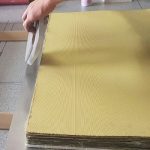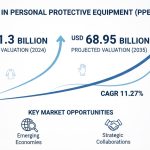The Flexible Packaging Market: Innovation, Sustainability, and Growth Trajectories
The flexible packaging market stands as one of the most dynamic segments within the global packaging industry, demonstrating remarkable resilience and consistent growth patterns. According to analysts at Vantage Market Research, the Global Flexible Packaging Market was valued at USD 258.42 Billion in 2022 and is projected to reach a substantial USD 359.13 Billion by 2030, exhibiting a steady Compound Annual Growth Rate (CAGR) of 4.20% throughout the forecast period. This growth trajectory underscores the increasing preference for flexible packaging solutions across various industries and consumer segments worldwide.
Flexible packaging derives its name from its ability to easily change shape when filled and during use, offering significant advantages over rigid packaging alternatives. At the core of flexible packaging’s success lies its versatility in material composition. The market predominantly utilizes polyethylene (PE), polypropylene (PP), polyethylene terephthalate (PET), polyamide (PA), ethylene vinyl alcohol (EVOH), and various biodegradable polymers. Additionally, aluminum foil, paper, and cellulose-based materials play crucial roles in creating multi-layer structures that enhance barrier properties and extend shelf life. These materials can be used individually or in sophisticated combinations to create packaging solutions tailored to specific product requirements regarding oxygen, moisture, light, and temperature sensitivity.
The food and beverage industry represents the largest end-user segment for flexible packaging, accounting for approximately 60% of the total market share. The inherent advantages of flexible packaging—including extended shelf life, product protection, reduced material usage, and lower transportation costs—make it particularly attractive for food applications ranging from snacks and confectionery to dairy, meat, and ready-to-eat meals. The pharmaceutical sector follows as another significant consumer, valuing flexible packaging for its barrier properties, tamper-evidence capabilities, and dose control features. Personal care and cosmetics, household products, and industrial goods round out the major application sectors, each contributing substantially to market expansion.
The technological landscape of flexible packaging continues to evolve, with advancements in material science enabling thinner, stronger, and more functional films. High-barrier materials that maintain product integrity while reducing overall packaging weight represent a significant area of innovation. Digital printing technologies have revolutionized the aesthetic and customization possibilities, allowing for high-quality graphics, variable data printing, and shorter production runs. Smart packaging technologies, including QR codes, NFC tags, and temperature indicators, are increasingly integrated into flexible packaging solutions, enhancing consumer engagement and providing valuable product information.
Sustainability has emerged as a defining factor reshaping the flexible packaging landscape. Manufacturers are increasingly focused on developing mono-material structures that facilitate recycling, incorporating post-consumer recycled content, and exploring compostable and biodegradable alternatives. This sustainability push is driven by a combination of consumer demand, regulatory pressures, and corporate environmental commitments. Despite these advancements, the industry continues to navigate challenges related to recycling infrastructure, material performance, and cost considerations, highlighting the complex balance between environmental responsibility and functional requirements in modern packaging design.
Stay Updated with Market Movements: Get Your Sample Report!
Market Dynamics
The flexible packaging market operates within a complex ecosystem of drivers, restraints, opportunities, and trends that collectively shape its development trajectory. Understanding these dynamics is essential for stakeholders seeking to navigate this evolving landscape effectively and strategically position themselves for future growth.
Key drivers propelling the flexible packaging market include the rising consumer preference for convenience-oriented products that align with modern, fast-paced lifestyles. Flexible packaging’s lightweight nature, resealability features, and easy-open options address these convenience demands directly. Urbanization and changing household structures, particularly the growth of single-person households and dual-income families, have accelerated the demand for portion-controlled, ready-to-eat, and on-the-go food products that rely heavily on flexible packaging solutions. The global push toward sustainability represents another significant driver, with flexible packaging offering substantial material reduction benefits compared to rigid alternatives—often requiring up to 70% less material to package the same volume of product, resulting in lower carbon footprints across the value chain.
Despite its growth trajectory, the market faces notable restraints that temper its expansion potential. Recycling challenges remain at the forefront, as multi-layer structures, while offering superior barrier properties, create significant difficulties for conventional recycling processes. The volatility of raw material prices, particularly petroleum-derived polymers, introduces cost uncertainties that can compress profit margins and complicate long-term planning for manufacturers. Additionally, regulatory complexities vary substantially across regions, with some jurisdictions implementing strict requirements regarding material composition, migration limits, and end-of-life management, creating compliance challenges for companies operating in global markets.
The market landscape is rich with opportunities for innovation and differentiation. The e-commerce boom has created a substantial demand for packaging solutions that balance product protection during shipping with material efficiency and unboxing experiences. Emerging markets in Asia, Africa, and Latin America present significant growth potential as rising disposable incomes, expanding middle classes, and evolving retail infrastructures drive increased consumption of packaged goods. Technology integration opportunities abound, with advances in barrier materials, active packaging, and digital connectivity enabling new functionalities that add value beyond basic containment and protection.
Current trends shaping the flexible packaging market include the accelerating shift toward mono-material structures designed for recyclability without compromising performance characteristics. Paper-based flexible packaging solutions are gaining traction as alternatives to plastic, particularly for applications where shorter shelf life requirements permit the use of materials with lower barrier properties. Digitalization across the value chain—from design and production to consumer interaction—is transforming how packaging communicates with consumers and integrates into broader product experiences. Premium packaging aesthetics, including matte finishes, tactile elements, and metallic effects, continue to gain prominence as brands seek shelf differentiation in competitive retail environments.
The COVID-19 pandemic has significantly influenced market dynamics, accelerating certain pre-existing trends while introducing new considerations. The heightened focus on hygiene and food safety has increased demand for hermetically sealed packaging options, while supply chain disruptions have emphasized the importance of regional production capabilities and material diversification strategies. As the market continues to evolve, stakeholders must remain attuned to these dynamic forces to effectively capitalize on emerging opportunities while navigating the challenges inherent in this transformative period for the packaging industry.
Market Segments
The flexible packaging market exhibits a multifaceted segmentation structure that reflects the diversity of materials, technologies, and applications characterizing this dynamic industry. This segmentation provides essential frameworks for understanding market opportunities, competitive positioning, and innovation pathways across the flexible packaging value chain.
By materials, the market divides into several key categories that form the foundation of flexible packaging performance. Plastic films dominate the material landscape, with polyethylene (particularly LDPE and LLDPE) representing the largest volume due to its versatility, cost-effectiveness, and excellent moisture barrier properties. Polypropylene follows closely, valued for its heat resistance, clarity, and stiffness that enable applications ranging from snack packaging to retort pouches. Polyester (PET) films provide outstanding tensile strength and temperature stability, making them ideal for applications requiring dimensional stability and puncture resistance. Aluminum foil, despite its higher cost, maintains a significant market presence due to its unparalleled barrier properties against oxygen, light, and moisture—essential for sensitive products like pharmaceuticals and certain food items. Paper-based materials have gained renewed attention amid sustainability concerns, offering recyclability advantages while providing excellent printability and natural aesthetics that resonate with eco-conscious consumers. Bioplastics represent the fastest-growing material segment, with compounds derived from corn, sugarcane, and other renewable sources addressing the market’s sustainability imperatives, though often at premium price points and with performance trade-offs that continue to evolve through ongoing R&D efforts.
When segmented by packaging type, pouches represent the largest and fastest-growing category, with stand-up pouches experiencing particular momentum due to their excellent shelf presence, convenience features, and material efficiency. Bags and sacks maintain substantial market share, particularly in industrial applications, bulk food packaging, and developing economies where cost sensitivity may outweigh premium packaging considerations. Rollstock continues to serve as the foundation for form-fill-seal operations across food, pharmaceutical, and personal care applications, offering high-speed manufacturing advantages. Wraps and films, including stretch and shrink variants, maintain their significance in secondary and tertiary packaging applications, while lidding films address the specialized needs of tray-sealed products across fresh food, dairy, and prepared meal categories.
The printing technology segment reflects the critical role of visual communication in modern packaging. Flexography remains the dominant technology for flexible packaging, offering an optimal balance of quality, speed, and cost-effectiveness for medium to long production runs. Rotogravure maintains its position in premium applications where image quality and consistency are paramount, particularly for global brands with standardized packaging across multiple markets. Digital printing represents the fastest-growing segment, enabling short runs, personalization, and variable data printing that address evolving retail and brand requirements. The remaining market share is divided among offset, letterpress, and screen printing technologies, each serving specific niche applications within the broader flexible packaging ecosystem.
By end-use industry, food packaging constitutes the largest segment, with further sub-segmentation across snack foods, confectionery, dairy, bakery, fresh produce, meat and seafood, and ready meals—each with distinct barrier, shelf life, and functionality requirements. Beverages represent a growing application area, particularly for stand-up pouches with spouts that offer material reduction compared to rigid alternatives. Pharmaceuticals demand the highest performance specifications, driving innovation in high-barrier structures, child-resistant features, and anti-counterfeiting technologies. Personal care and cosmetics leverage flexible packaging for its dispensing precision, product protection, and premium decoration capabilities. Industrial applications, while less visible to consumers, comprise a substantial volume segment, with heavy-duty films and bags serving agricultural, chemical, and construction sectors with emphasis on strength, durability, and cost-effectiveness rather than aesthetic considerations.
This multidimensional segmentation landscape underscores the complexity and diversity of the flexible packaging market, with each segment experiencing distinct growth rates, competitive dynamics, and innovation priorities. Successful market participants increasingly recognize the importance of specialized expertise within specific segment combinations rather than pursuing generalized approaches across the entire market spectrum.
Factors Driving Market Growth
The remarkable growth trajectory of the flexible packaging market is propelled by several interconnected factors that collectively create a favorable environment for sustained expansion. Understanding these growth drivers provides essential context for stakeholders navigating this dynamic industry landscape.
E-commerce has emerged as a transformative force in the packaging industry, fundamentally altering requirements and priorities for product protection, efficiency, and consumer experience. The global e-commerce market has experienced explosive growth, accelerated by the COVID-19 pandemic, with online retail sales exceeding 4.9 trillion globally in 2021 and projected to surpass 7.4 trillion by 2025. This shift in shopping patterns has created unprecedented demand for packaging solutions that balance protection during complex logistics chains with material efficiency and sustainability considerations. Flexible packaging addresses these requirements through lightweight designs that minimize shipping costs while maintaining product integrity. The rise of e-commerce has also elevated the importance of the unboxing experience as a brand touchpoint, driving innovation in easy-open features, resealability, and premium aesthetics that enhance consumer satisfaction. Direct-to-consumer brands in particular have embraced flexible packaging for its ability to combine functional performance with distinctive brand expressions that resonate in social media environments where unboxing content proliferates. Additionally, e-commerce has accelerated the adoption of right-sized packaging solutions that minimize void fill requirements, with flexible formats offering significant advantages over rigid alternatives in terms of adaptability to varying product dimensions.
The sustainability imperative represents another fundamental driver reshaping the flexible packaging landscape. Corporate sustainability commitments, consumer preferences, and regulatory pressures have converged to elevate environmental considerations from optional differentiators to essential requirements. Major brand owners and retailers have established ambitious packaging targets, including 100% recyclable, reusable, or compostable packaging by 2025 or 2030, creating substantial demand for sustainable flexible packaging solutions. Life cycle assessment (LCA) studies consistently demonstrate the environmental advantages of flexible packaging in terms of reduced material usage, transportation efficiency, and lower energy consumption during manufacturing—with flexible pouches typically generating 60-70% less CO2 emissions than comparable rigid containers. These environmental benefits have motivated significant investments in recyclable mono-material structures that maintain performance while addressing end-of-life concerns. Extended Producer Responsibility (EPR) schemes being implemented across various regions have further accelerated the sustainability focus by making packaging producers financially responsible for collection and recycling systems, creating direct economic incentives for environmentally optimized designs. The development of chemical recycling technologies offers promising pathways for handling complex multi-layer structures that cannot be processed through conventional mechanical recycling, potentially addressing one of the most significant sustainability challenges facing the industry.
Technological advancements and intensified R&D efforts continue to expand the capabilities and applications of flexible packaging. Material science innovations have enabled significant downgauging without compromising performance, with some films achieving 20-30% thickness reductions over the past decade while maintaining or improving barrier properties. High-barrier technologies have evolved beyond conventional metallization to include transparent barrier solutions such as silicon oxide (SiOx) and aluminum oxide (AlOx) coatings that provide oxygen and moisture protection while enabling product visibility. Active packaging technologies that extend shelf life through oxygen scavengers, moisture regulators, and antimicrobial properties have expanded the application range of flexible packaging into sensitive product categories previously dominated by rigid alternatives. Digital printing advancements have transformed decoration capabilities, enabling photographic-quality graphics, variable data printing, and personalization options that enhance consumer engagement. Smart packaging technologies incorporating NFC chips, QR codes, and sensors that monitor product freshness, temperature exposure, and authenticity have added new dimensions of functionality beyond traditional containment and protection roles.
The flexible packaging industry’s growth is further supported by evolving consumer demographics and lifestyle patterns. The rise of single-person households, which now represent over 30% of all households in many developed economies, has increased demand for portion-controlled packaging that prevents food waste while maintaining freshness through reclosable features. Time-pressed consumers increasingly prioritize convenience, driving the expansion of ready-to-eat meals, snack foods, and on-the-go consumption formats that leverage flexible packaging’s portability and ease of use. Health and wellness trends have created new product categories requiring specialized barrier properties to protect natural ingredients and avoid preservatives, while the premiumization of everyday items has elevated packaging’s role in communicating quality and differentiation at the point of sale.
These converging drivers—e-commerce expansion, sustainability imperatives, technological innovation, and evolving consumer preferences—collectively create a robust foundation for the flexible packaging market’s continued growth, with each factor reinforcing and accelerating the others in a virtuous cycle of development and adoption.
Challenges Facing the Flexible Packaging Industry
Despite its impressive growth trajectory, the flexible packaging industry confronts several significant challenges that require strategic responses and collaborative solutions across the value chain. These challenges create both constraints on market development and opportunities for differentiation through innovative problem-solving approaches.
Raw material cost volatility and availability issues represent persistent challenges for flexible packaging manufacturers, directly impacting operational stability and profit margins. Polymers derived from petroleum feedstocks remain the primary material input for flexible packaging, creating direct exposure to oil price fluctuations that can be sudden and significant. The 2021-2022 period demonstrated this vulnerability, with polyethylene prices experiencing increases exceeding 40% in some regions due to a combination of feedstock cost increases, supply chain disruptions, and extraordinary weather events affecting production facilities. This volatility complicates pricing strategies, contract negotiations, and long-term planning for packaging converters operating on traditionally thin margins. Beyond cost considerations, supply chain resilience has emerged as a critical concern, with the COVID-19 pandemic revealing vulnerabilities in global material sourcing networks. Force majeure declarations by major resin suppliers during 2020-2021 created extended material shortages that disrupted production schedules and required manufacturers to qualify alternative suppliers and materials under compressed timeframes. The growing emphasis on specialty resins for sustainable and high-performance applications further complicates the supply landscape, as these materials often have more limited production capacity and fewer alternative suppliers than commodity grades. Forward-thinking manufacturers have responded by implementing more sophisticated procurement strategies, including indexed pricing models, expanded supplier networks, material diversification efforts, and vertical integration initiatives to mitigate these challenges.
The complexity of recycling processes for flexible packaging represents perhaps the most significant challenge to the industry’s sustainability narrative and long-term growth potential. While flexible packaging offers substantial front-end sustainability benefits through material reduction, these advantages are partially offset by end-of-life challenges. Multi-material laminates that combine different polymers, aluminum, and paper to achieve required barrier properties create significant recycling difficulties, as these materials cannot be effectively separated in conventional recycling processes. The light weight of flexible packaging, while beneficial for transportation efficiency, creates collection challenges, as these materials contribute little to weight-based recycling targets that drive municipal program priorities. The high surface-area-to-volume ratio of flexible packaging results in significant contamination with food residues that can compromise recycling process efficiency. Infrastructure limitations compound these challenges, with many existing material recovery facilities (MRFs) lacking the optical sorting capabilities required to effectively capture and separate flexible materials from waste streams. The economics of flexible packaging recycling remain challenging, as the material value often fails to offset collection and processing costs, creating a fundamental market failure that requires policy interventions or voluntary industry initiatives to address. The industry has responded through collaborative efforts like the Flexible Packaging Association’s RECOVER Coalition and CEFLEX in Europe, which bring together stakeholders across the value chain to develop design guidelines, improve collection systems, and establish viable end markets for recycled flexible materials.
Competition from rigid packaging alternatives continues to challenge flexible packaging’s market position, particularly in premium product segments and categories where consumer perceptions favor traditional packaging formats. Glass packaging maintains significant market share in beverage, premium food, and personal care applications, supported by its perceived quality associations, unlimited recyclability, and inert product contact properties. Metal packaging, particularly aluminum cans, has experienced renewed growth in beverage applications, bolstered by substantial investments in sustainability messaging and recycling infrastructure development that has created strong circular economy narratives. Rigid plastic containers offer advantages in stackability, product protection, and consumer handling that continue to resonate in certain applications despite their higher material intensity. These competitive dynamics are particularly evident in emerging markets, where evolving consumer preferences may initially favor rigid packaging formats associated with developed market premium positioning before transitioning toward the convenience and efficiency benefits of flexible alternatives. The challenge for flexible packaging producers lies in effectively communicating their products’ full sustainability profile rather than focusing exclusively on end-of-life considerations where rigid alternatives may hold advantages in consumer perception and existing infrastructure compatibility.
Regulatory complexity and uncertainty create additional challenges for the flexible packaging industry, with different regions implementing varied approaches to packaging legislation. The European Union’s Single-Use Plastics Directive, Extended Producer Responsibility requirements, and Circular Economy Action Plan have created the world’s most demanding regulatory environment for packaging, with significant implications for material selection, design approaches, and business models. The absence of harmonized regulations across countries creates compliance challenges for global brands seeking standardized packaging solutions, while rapidly evolving regulatory requirements necessitate continuous monitoring and adaptation. Food contact regulations add another layer of complexity, with different jurisdictions maintaining varied approaches to migration limits, positive lists of approved substances, and testing methodologies. The regulatory uncertainty surrounding emerging contaminants of concern, including per- and polyfluoroalkyl substances (PFAS) used in grease-resistant applications, creates additional risk factors that require proactive management approaches.
These challenges—material volatility, recycling complexity, competitive pressures, and regulatory demands—create a complex operating environment that requires strategic responses at both individual company and industry-wide levels. The industry’s ability to effectively address these challenges will significantly influence its long-term growth trajectory and sustainability positioning in the broader packaging landscape.
Regional Growth Insights
The flexible packaging market exhibits distinctive regional characteristics and growth patterns that reflect varying economic development stages, consumer preferences, regulatory environments, and industry maturity levels across global geographies. Understanding these regional dynamics provides essential context for strategic decision-making regarding market entry, expansion priorities, and investment allocations.
The Asia Pacific region stands as the dominant force in the global flexible packaging market, accounting for approximately 40% of global consumption and exhibiting the highest growth rates among major regions. China represents the single largest market within this region, driven by its massive population, rapidly expanding middle class, and continued urbanization that accelerates the transition from unpackaged to packaged goods across numerous product categories. The Chinese flexible packaging market has evolved from primarily serving export-oriented manufacturing to increasingly addressing sophisticated domestic consumption patterns, with significant quality and capability improvements among local converters reducing the historical reliance on imported materials. India presents perhaps the most compelling growth story within the region, with its flexible packaging consumption projected to grow at 8-10% annually through 2030, substantially outpacing global averages. This exceptional growth is fueled by favorable demographics, rising disposable incomes, and the ongoing transformation of retail infrastructure from traditional markets to modern trade formats that increase packaged goods penetration. Southeast Asian nations, particularly Indonesia, Vietnam, and Thailand, contribute substantially to regional growth, benefiting from manufacturing shifts from China and rapidly developing domestic consumer markets. Japan presents a contrasting profile within the region, with its mature market focusing on high-value innovation, particularly in the areas of convenience features, portion control, and premium aesthetics that address the needs of its aging, predominantly urban population with sophisticated packaging expectations.
North America represents a mature yet innovative flexible packaging market characterized by high per capita consumption, advanced converting capabilities, and sophisticated brand requirements. The United States accounts for approximately 90% of the North American market, with strong positions across food, beverage, pharmaceutical, and personal care applications. The region’s growth, while more modest than emerging markets at 2-3% annually, is driven primarily by innovation in convenience features, sustainability solutions, and e-commerce adaptations rather than fundamental increases in packaged goods penetration. North American converters have pioneered numerous technological advancements, including high-barrier films, precision registration control, and digital printing applications that have subsequently been adopted globally. The region’s retail landscape, dominated by large-format stores and e-commerce, has shaped packaging requirements toward shelf impact, shipping durability, and consumer convenience features. Sustainability considerations have gained significant momentum across North America, with major retailers and brand owners establishing ambitious packaging commitments that are accelerating the transition toward recyclable flexible packaging solutions, though infrastructure limitations continue to create implementation challenges for circular economy approaches.
The European flexible packaging market combines mature Western European markets with higher-growth opportunities in Eastern Europe, creating a diverse regional landscape unified by increasingly stringent regulatory requirements. Germany, France, Italy, and the UK represent the largest individual markets, with sophisticated converting operations serving both domestic consumption and export markets. The European region leads global sustainability initiatives, with the Circular Economy Action Plan and Single-Use Plastics Directive creating the world’s most demanding regulatory environment for packaging materials and waste management. These requirements have accelerated innovation in recyclable mono-material structures, paper-based alternatives, and compostable solutions that address end-of-life considerations while maintaining functional performance. The CEFLEX initiative exemplifies Europe’s collaborative approach to flexible packaging sustainability, bringing together over 180 stakeholders across the value chain to develop design guidelines, infrastructure recommendations, and end-market applications for collected materials. Eastern European markets, including Poland, Hungary, and Romania, offer stronger growth prospects than their Western counterparts, benefiting from manufacturing investments, improving retail infrastructure, and increasing consumer purchasing power that drives packaged goods consumption.
Latin America presents a region of contrasts, with Brazil and Mexico representing the dominant markets while smaller countries exhibit varying development stages and growth patterns. Economic volatility has historically characterized the region, creating challenges for long-term investment planning, though gradual stabilization has improved the outlook for packaging demand growth. The region benefits from a strong agricultural base that drives food processing activities requiring flexible packaging solutions, while its youthful demographic profile supports growth in convenience-oriented product categories. Limited recycling infrastructure creates challenges for sustainable packaging initiatives, though increasing environmental awareness is gradually elevating sustainability considerations in purchasing decisions. The fragmented retail landscape, with traditional markets maintaining significant shares alongside growing modern trade formats, requires packaging solutions that address diverse distribution channels and consumer preferences, often necessitating different approaches than those employed in more developed regions.
The Middle East and Africa region offers substantial long-term growth potential, though from a relatively small current base and with significant variations in market maturity across countries. The Gulf Cooperation Council nations exhibit consumption patterns more closely resembling developed markets, with high penetration of packaged goods and sophisticated consumer expectations. North African countries are experiencing increasing flexible packaging adoption driven by urbanization, tourism-related food service growth, and expanding modern retail formats. Sub-Saharan Africa represents a longer-term opportunity, with current per capita packaging consumption remaining low but poised for acceleration as incomes rise, urbanization continues, and multinational consumer goods companies increase their presence in these high-potential markets. Across the region, the hot and often humid climate creates demands for high-barrier packaging solutions that protect product integrity under challenging environmental conditions, while infrastructure limitations regarding cold chains elevate the importance of packaging in extending ambient shelf life for food products.
These regional variations in market characteristics, growth drivers, and development trajectories underscore the importance of geographically tailored strategies for flexible packaging manufacturers and brand owners seeking to optimize their global approaches. While certain trends—particularly sustainability focus and e-commerce growth—cut across regions, their specific manifestations and implementation timeframes require nuanced approaches that recognize the distinctive attributes of each major geographical market.
Major Players in the Flexible Packaging Market
The competitive landscape of the flexible packaging market features a diverse array of participants ranging from global integrated suppliers to specialized regional converters, each positioning themselves distinctively within this complex and evolving industry. Understanding the strategic approaches of major players provides valuable insights into market dynamics, innovation pathways, and competitive differentiation opportunities.
Among the industry’s leading global players, Amcor plc stands as the largest flexible packaging company following its transformative acquisition of Bemis Company in 2019, which created a combined entity with approximately 13 billion in annual revenue and operations spanning 43 countries. Amcor’s strategic focus centers on leveraging its global scale to drive operational excellence while maintaining regional responsiveness to customer needs—an approach that balances efficiency with market adaptability. The company has established itself as a sustainability leader through its “AMCOR 2025” commitments, which include making all packaging recyclable or reusable by 2025 and increasing the use of recycled materials. Amcor’s R&D efforts have produced numerous innovations, including its AmLite recyclable high-barrier films and RecycleReady pouches that maintain performance while addressing end-of-life considerations. Berry Global Group represents another major industry force with approximately 11 billion in annual revenue across packaging segments including flexible films, nonwovens, and rigid packaging. Berry’s strategy emphasizes customer-focused innovation and material science expertise, with significant investments in recyclable structures and incorporation of post-consumer recycled content. Sealed Air Corporation, with its focus on protective packaging and food solutions, has strategically positioned itself at the intersection of food safety, automation, and sustainability through its “Sealed Air Operational Excellence” business system and 2025 Sustainability and Plastics Pledge.
European-based global players bring distinctive approaches to the market, with Mondi Group emphasizing its integrated business model that spans paper and plastic film production through converting operations, creating unique capabilities in hybrid paper-plastic solutions that address sustainability objectives. Mondi’s “EcoSolutions” approach exemplifies its customer-centric innovation process that evaluates opportunities to replace, reduce, and recycle packaging materials while maintaining functional requirements. Huhtamaki, with its origins in Finland but operations spanning 35 countries, has established strong positions in both fiber and flexible packaging, with particular strength in confectionery, pet food, and coffee applications. The company’s “Blueloop” recyclable flexible packaging structures demonstrate its commitment to circular economy principles. Constantia Flexibles, headquartered in Austria, has focused its strategy on pharmaceutical and consumer packaging, with particular expertise in high-barrier applications and aluminum-based solutions that has positioned it as a leader in sensitive product applications requiring exceptional protection properties.
Asian packaging leaders have increasingly expanded beyond their regional bases to establish global footprints, with Dai Nippon Printing (DNP) and Toppan exemplifying Japan’s sophisticated converting capabilities and technological leadership, particularly in high-barrier films and functional coatings. Both companies have leveraged their historical strengths in printing technologies to develop advanced packaging solutions that incorporate decorative elements, anti-counterfeiting features, and interactive functionalities. Chinese players including Jinjiang Jiaxing, Zhejiang Kinlead Innovative Materials, and Hubei Huakang Pharmaceutical Packaging have rapidly expanded their capabilities and international presence, initially competing on cost advantages but increasingly developing technical capabilities that allow them to serve multinational brand owners with sophisticated requirements.
The industry has experienced significant consolidation through strategic acquisitions aimed at expanding geographical footprints, accessing new technologies, and diversifying customer bases. Private equity firms have played notable roles in this consolidation trend, with firms like Bain Capital, Apollo Global Management, and Clayton, Dubilier & Rice making significant investments in packaging companies, often implementing operational improvement initiatives before returning these businesses to public markets or strategic buyers at premium valuations. This financial investor activity has accelerated industry transformation while creating enlarged entities with enhanced resources for capital investment and innovation initiatives.
The innovation focus across major players demonstrates several consistent themes, particularly regarding sustainability advancements. Recyclable mono-material structures represent perhaps the most significant development area, with companies including ProAmpac, TC Transcontinental, and Printpack introducing solutions that eliminate non-recyclable layers while maintaining barrier properties through advanced material formulations and coating technologies. Compostable and biodegradable solutions have attracted substantial R&D investment, with TIPA, Futamura, and Novamont leading development of bio-based alternatives for applications where traditional recycling presents challenges. Digital printing technologies have been embraced by forward-thinking converters including ePac Flexible Packaging, which has pioneered a business model centered exclusively on digital production that enables economical short runs, personalization capabilities, and rapid turnaround times that address emerging brand requirements for market responsiveness and customization.
Strategic partnerships and collaborations have become increasingly important as companies recognize that addressing complex sustainability challenges requires expertise beyond any single organization’s capabilities. The New Plastics Economy initiative, led by the Ellen MacArthur Foundation, has brought together brand owners, packaging suppliers, recyclers, and other stakeholders to develop systemic solutions to plastic packaging challenges. Materials companies including Dow, Nova Chemicals, and ExxonMobil Chemical have established partnerships with converters to develop recyclable polyethylene-based structures that maintain performance while improving sustainability profiles. Machinery manufacturers like Bobst, Windmöller & Hölscher, and Nordmeccanica have collaborated with material suppliers and converters to develop equipment specifically designed for sustainable materials that may present different processing characteristics than conventional structures.
As the industry continues to evolve, competitive differentiation increasingly depends on strategic clarity regarding target markets, technical capabilities, and sustainability positioning. While some players pursue broad market coverage and integrated operations, others have achieved success through specialized focus on particular applications, technologies, or customer segments that allow for distinctive value propositions and dedicated expertise development. This specialization trend is particularly evident among mid-sized regional converters who leverage their agility, customer intimacy, and application focus to compete effectively against larger global entities in specific market niches.
Future Trends and Opportunities
The flexible packaging industry stands at an inflection point, with several transformative trends reshaping its trajectory and creating new opportunities for innovation, differentiation, and value creation. Organizations that effectively anticipate and respond to these emerging dynamics will be well-positioned to thrive in the evolving packaging landscape.
The shift toward circular economy practices represents perhaps the most fundamental transformation underway in the flexible packaging sector. This transition extends beyond incremental improvements to envision a comprehensive redesign of materials, processes, and business models that eliminate the concept of waste and keep resources in productive use across multiple lifecycles. Design for recycling has become a central principle in this transition, with material selection, structure simplification, and compatibility with existing recycling infrastructure guiding development decisions. The momentum behind mono-material structures continues to accelerate, with polyethylene-based solutions gaining particular traction due to their recyclability in existing PE streams and versatility across various applications. Advanced sorting technologies, including digital watermarking and chemical tracers, promise to improve the identification and separation of flexible packaging in recycling facilities, addressing a critical infrastructure limitation. Chemical recycling technologies that convert polymers back to their molecular building blocks offer promising pathways for handling complex structures that cannot be effectively processed through mechanical recycling, potentially closing the loop for materials previously considered unrecyclable. Beyond technical considerations, business model innovation plays an increasingly important role in circular economy implementation, with packaging-as-a-service concepts, takeback programs, and material pooling arrangements creating new approaches to resource stewardship. The Holy Grail 2.0 initiative exemplifies this collaborative approach, bringing together more than 130 companies across the value chain to develop and test digital watermarking technologies that enable more precise sorting of packaging materials.
The demand for biodegradable and recyclable options continues to gain momentum, driven by consumer awareness, regulatory pressures, and brand commitments. Bio-based polymers derived from renewable resources such as corn, sugarcane, and cellulose have experienced compound annual growth rates exceeding 20%, albeit from a relatively small base. These materials address both feedstock sustainability and end-of-life concerns, though challenges regarding cost, performance, and infrastructure compatibility persist. Polylactic acid (PLA), polyhydroxyalkanoates (PHA), and thermoplastic starch (TPS) represent the most widely adopted bio-based polymers in flexible packaging applications, each offering distinct property profiles and degradation characteristics suited to different applications. Cellulose-based films have experienced renewed interest, particularly for applications where shorter shelf life requirements permit the use of materials with more limited barrier properties. Paper-based flexible packaging has gained significant traction, with innovative coatings and treatments enhancing its barrier properties and functional performance while maintaining its excellent recyclability and biodegradability profile. Beyond material innovation, the development of appropriate collection and processing infrastructure for compostable packaging represents a critical enabling factor for widespread adoption, with industrial composting facilities and home composting education programs expanding across developed markets.
Customization and personalization in packaging design has emerged as a significant trend responding to evolving brand requirements and retail dynamics. Digital printing technologies have been transformative in this space, enabling economical short runs, variable data printing, and quick turnaround times that support limited editions, regional variations, and personalized packaging campaigns that strengthen consumer connections. Beyond aesthetic considerations, structural customization has advanced through modular design approaches and parametric engineering tools that allow packaging dimensions and features to be precisely tailored to product requirements while maintaining production efficiency. Mass customization capabilities have progressed substantially, with web-to-pack platforms enabling brand owners to configure packaging specifications through intuitive interfaces that seamlessly connect to digital production workflows. These customization capabilities have proven particularly valuable for emerging brands, direct-to-consumer businesses, and products targeting specific consumer segments or occasions where packaging plays a crucial role in brand storytelling and differentiation.
Technological convergence represents another transformative trend, with flexible packaging increasingly incorporating elements of digital connectivity, active functionality, and extended intelligence. Smart packaging technologies have evolved beyond QR codes to include near-field communication (NFC) tags, radio-frequency identification (RFID), and printed electronics that create new consumer interaction possibilities while providing valuable data on product usage and supply chain conditions. Active packaging technologies that extend shelf life through oxygen scavengers, moisture regulators, and antimicrobial properties have expanded the application range of flexible packaging into sensitive product categories previously requiring more protective formats. Intelligent indicators that monitor product freshness, temperature exposure, and package integrity provide visual signals that enhance consumer confidence and food safety. These technological integrations are increasingly moving from novelty applications to mainstream implementations as costs decrease, technical performance improves, and consumers become more familiar with interactive packaging experiences.
Automation and digitalization across the packaging value chain continue to accelerate, transforming production capabilities, supply chain management, and business models. Industry 4.0 principles have been widely embraced by leading converters, with connected equipment, predictive maintenance, and real-time process monitoring enhancing operational efficiency and quality consistency. Artificial intelligence applications have expanded into areas including defect detection, color management, and production scheduling optimization. Digital workflows spanning from design through prepress and production have compressed development timeframes while improving accuracy and reducing waste. Augmented reality tools have enhanced collaboration between brand owners and packaging suppliers, allowing virtual prototype evaluation and approval processes that accelerate time-to-market for new packaging developments. These digital transformations have proven particularly valuable in addressing recent supply chain challenges, with enhanced visibility and flexibility enabling more resilient operations amid disruption.
The flexible packaging industry’s future will be shaped by these converging trends, with successful organizations leveraging sustainability innovation, customization capabilities, technological integration, and digital transformation to create distinctive value propositions that address evolving market requirements. While challenges remain—particularly regarding recycling infrastructure development, material performance trade-offs, and cost considerations—the industry’s demonstrated capacity for innovation suggests a positive trajectory toward packaging solutions that effectively balance functional performance, environmental responsibility, and economic viability.
☎ Contact Us:
224 W 35th St Ste 500 New York,
USA/Canada Toll Free +1(877) 462-2282
+1(212) 951-1369
✉ Email: [email protected]
🌐 Website: https://www.vantagemarketresearch.com
FAQs
- What factors are driving growth in the Global Flexible Packaging Market?
- How is the Compound Annual Growth Rate (CAGR) calculated for the Flexible Packaging Market?
- What are the key trends influencing the Flexible Packaging Market from 2022 to 2030?
- How does the Global Flexible Packaging Market value compare across different regions?
![[Market Research Reports] – Research Google News Blog | VMR.Biz](https://www.vmr.biz/wp-content/uploads/2022/12/logo-removebg-preview.png)











